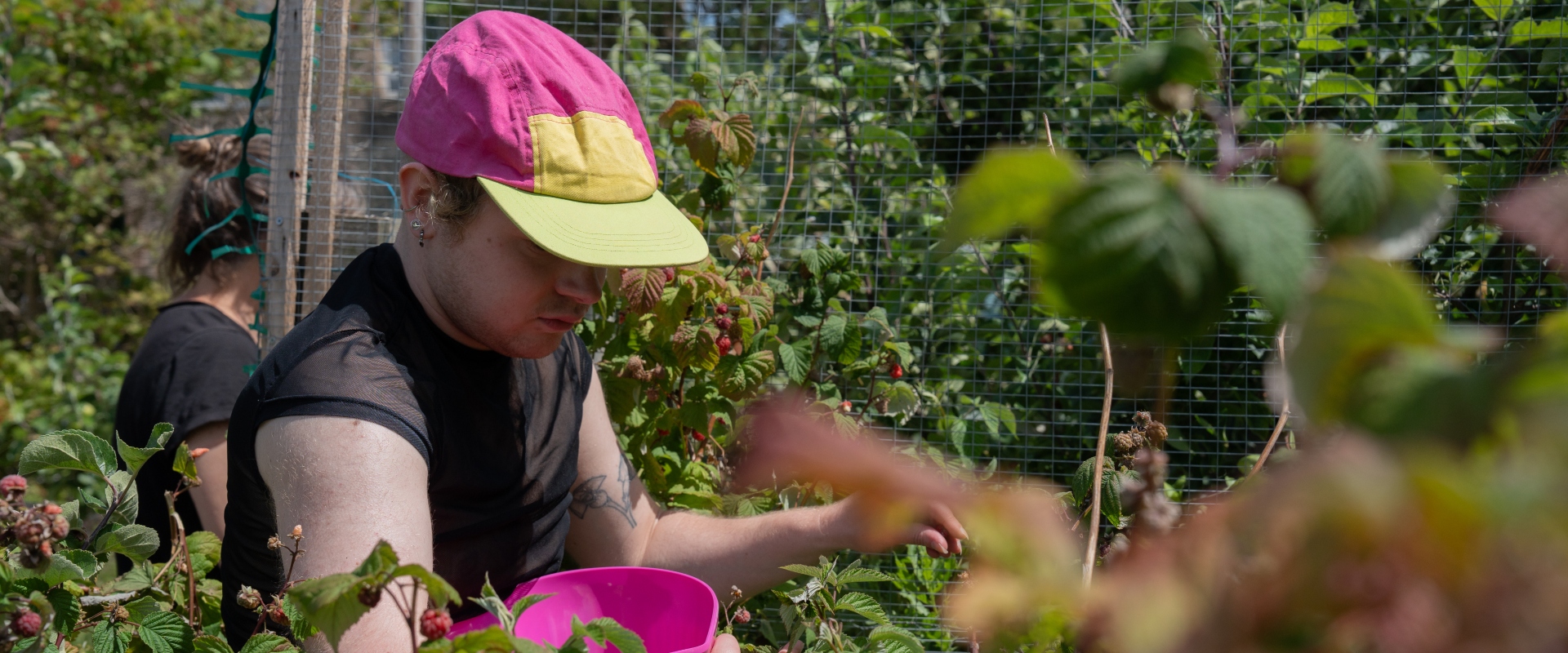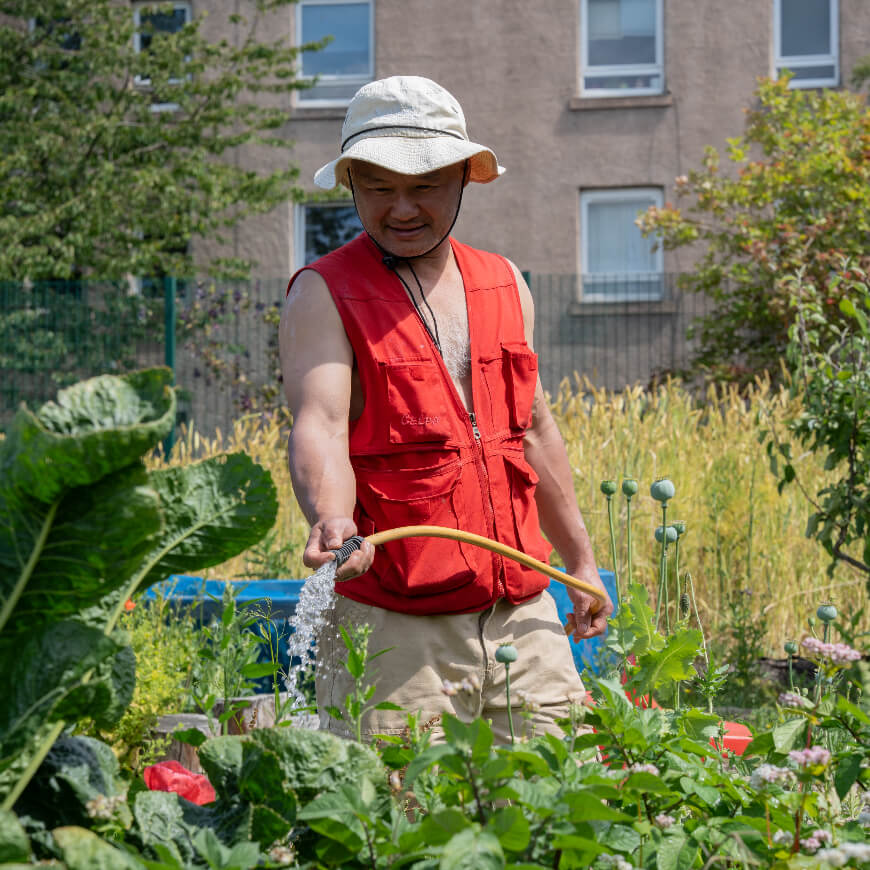
Community food growers’ guide
13-10-2025
Get started with...
Case study
©National Trust Images Rebecca Hughes

13-10-2025
Get started with...
Case study
©National Trust Images Rebecca Hughes
Community food growing is the idea that local people can come together to grow delicious food produce in neighbourhood spaces.
Food is a universal language, able to bridge cultural and social divides and root us back in nature and the outdoors. This recent (May 2025) report from the Coronation Gardens for Food and Nature project, funded by The National Lottery Heritage Fund, found that sowing and growing as a community has benefits including:
Anyone, anywhere can kick off a community food growing initiative. With 85% of the UK population living in urban areas, pockets of shared plots and gardens are a simple way to bring colour, connection and nature to unloved, grey spaces right on people’s doorsteps.
Read on to hear how people ‘in the grow’ planted the seeds of community food growing where they live, and the positive impact it’s had on those around them.
In a historically industrial district of north Edinburgh, you’ll find the Granton Community Gardeners growing, cooking and eating food together. Co-founder Tom Kirby shares their story.
You may share green space on an estate, want to transform a neglected corner or have no land at all.
You may have an organisation behind you, the support of a local group or be starting out on your own. The great news is it’s always possible to grow something, whatever your situation. From the heart of Granton, Tom shares the 10 ingredients in his recipe for success.
When you find a bit of land you think you could grow food on, it’s important to dig up more information and check it’s right for you:
Food for thought: ‘guerilla gardening’ is one way to show your idea works, improve an area, make people smile, build goodwill and gain support.
Food for thought: if there’s a chance a mowing team may come round, protect your planting by very obviously removing all grass from the area you’re using.
Food for thought: local authorities may be able to help you with soil testing/advice.
Water, kettles and toilets are essentials. If you have a water supply, you can always feed the plants you’re growing. If you have a kettle to make hot drinks, volunteers will be happier. If you have a toilet nearby, volunteers can spend more time at the community garden.
There may be ways to improvise all these things, especially in the short term and if volunteers are local. But for the long term and when volunteers coming from any distance, these basic facilities are essential for successful community food growing.
Begin by growing something, somewhere. Simply making the change from growing nothing to growing anything is the key to kickstarting momentum. If you’re unsure if something will work, try planting a small batch of it before you commit to investing more time and money.
Always be open to others joining you. Don’t worry if some are sceptical at first, keep an open invitation and make it feel like it’s everyone’s garden.
If you get on well as a group and enjoy what you’re doing, people are more likely to want to join. And when you have a shared goal, that good feeling grows and flourishes over time – helping you resolve differences and conflicts and achieve long term sustainability and success.
The act of transforming a space by creating a garden can naturally attract more local attention than a verbal announcement or written publicity. Especially when it’s somewhere people wouldn’t expect it.
Build on this positive PR by giving your new audience an easy way to contact you and join in.
Being present at the growing site at the same time each week will ensure people know where to find you.
Having full watering cans or trowels to hand gives people a quick and simple way to join the movement.
Remember that growing food is always an achievement, even for skilled growers with the ideal infrastructure. So enjoy every success and celebrate them together.
This is the simplest way to document your progress and is a powerful way of communicating what you do.
Food for thought: posting your photos on social media could help you reach an even wider and more diverse audience.
Photos can also be useful for tracking how your garden changes through the seasons and helping you observe what works and what doesn’t for future planting.
Make an informed decision about whether formalising your community food growing group is right for you by considering both the upsides and the downsides:
Informal groups
Formalised organisations
Food for thought: if you decide to formalise, ensure that everyone understands this is about benefitting from increased opportunities and capacity and not about loss of ownership.
This exciting, diverse and creative movement reaches across the UK and far beyond. There’s a huge amount to be gained by learning from and sharing with others. There’s also a wealth of experience and advice to draw on, including support organisations like Social Farms & Gardens.
There is no one-size-fits-all way to grow delicious food together. Here are some more organisations putting roots down in their communities across the UK.
Incredible Edible has a vision to create kind, confident and connected communities through the power of food. Founded in a northern market town over a decade ago, Incredible Edible is now a federation of over 200 local Incredible Edible. You can find your local group via their website and access resources to support you with setting up and running your own Incredible Edible group.
Visit Incredible Edible
Zebra Collective in Plymouth is working towards a just and sustainable society through culture change, community development, reflective practice and training. Zebra’s weekly Grow, Cook, Share Club sows vegetables to transform their neighbourhood centre garden for nature. It’s open to everyone, with an ambition to welcome underrepresented groups in the community such as asylum seekers and refugees especially.
More about Zebra CollectiveMafwa Theatre runs a gardening group that brings refugees, asylum seekers and settled communities together in the heart of Lincoln Green, Leeds. Once a disused playground, Roxby Community Garden is now a thriving green space open to all, where the ‘Lincoln Greeners’ group tackles seasonal gardening jobs and grows flowers and vegetables each week. The garden provides stability, peace and cultural connection, in particular for those far from home.
Meet the Lincoln Greeners
Octopus Community Network’s urban growing programme helps transform underused spaces into vibrant community gardens, connecting residents through seasonal workshops and ecological initiatives. Rooted in the rich diversity of Islington’s communities, the programme celebrates different cultures and perspectives. There’s a strong focus on repurposing social housing land for food growing and biodiversity, with “nature on our doorstep, not a destination.” At the heart of this is the Community Plant Nursery, nurturing a network of neighbourhood growers inspired by their communities.
Find out about Octopus
Earth in Common in Edinburgh started as a community movement to reclaim neglected common good land within a local part. It is now a thriving ‘urban croft’, with abundant food growing spaces that supply a bustling onsite café, regular food and farmers markets and learning opportunities. Earth in Common’s family spirit is rooted in its Highland croft heritage, bringing the community of Leith together as a force for good.
More about Earth in CommonHannah Fields mobilised the community of Littleover, Derby to help transform an overgrown two-acre green site that had been abandoned for more than two decades. It now provides the community with a vast selection of seasonal fruit and vegetables, a Forest School and children's activities, garden volunteering sessions and onsite café. At the heart of it all is a belief in the benefits of social connection, nature, holistic wellbeing and community.
Discover Hannah FieldsHorton Community Farm in inner-city Bradford is a centre for food growing and community resilience. On a site of abandoned allotments alongside residents tending their own allotments, the farm has a therapy garden, play area for children, wildlife areas, an orchard, a compost toilet, and cabins for storage. The community growing spaces bring together people seeking sanctuary, those with learning disabilities, young families, people in pregnancy and folk wishing to improve their mental and physical health.
Horton Community FarmGet free inspiration, ideas and advice for organising a community project or starting your own group.
The Wildlife Trusts Community Hub has simple, easy-to-understand guides that tell you how to find funding and run a group, plus everything you need to know about insurance, banks, health and safety and more. The hub was made possible thanks to The National Lottery Heritage Fund.
Meanwhile the ‘Grow Wild Guide’ created by the Royal Botanic Gardens, Kew, is packed with practical advice and tips on how to set up and run your own community growing project.

©National Trust Images / Rebecca Hughes